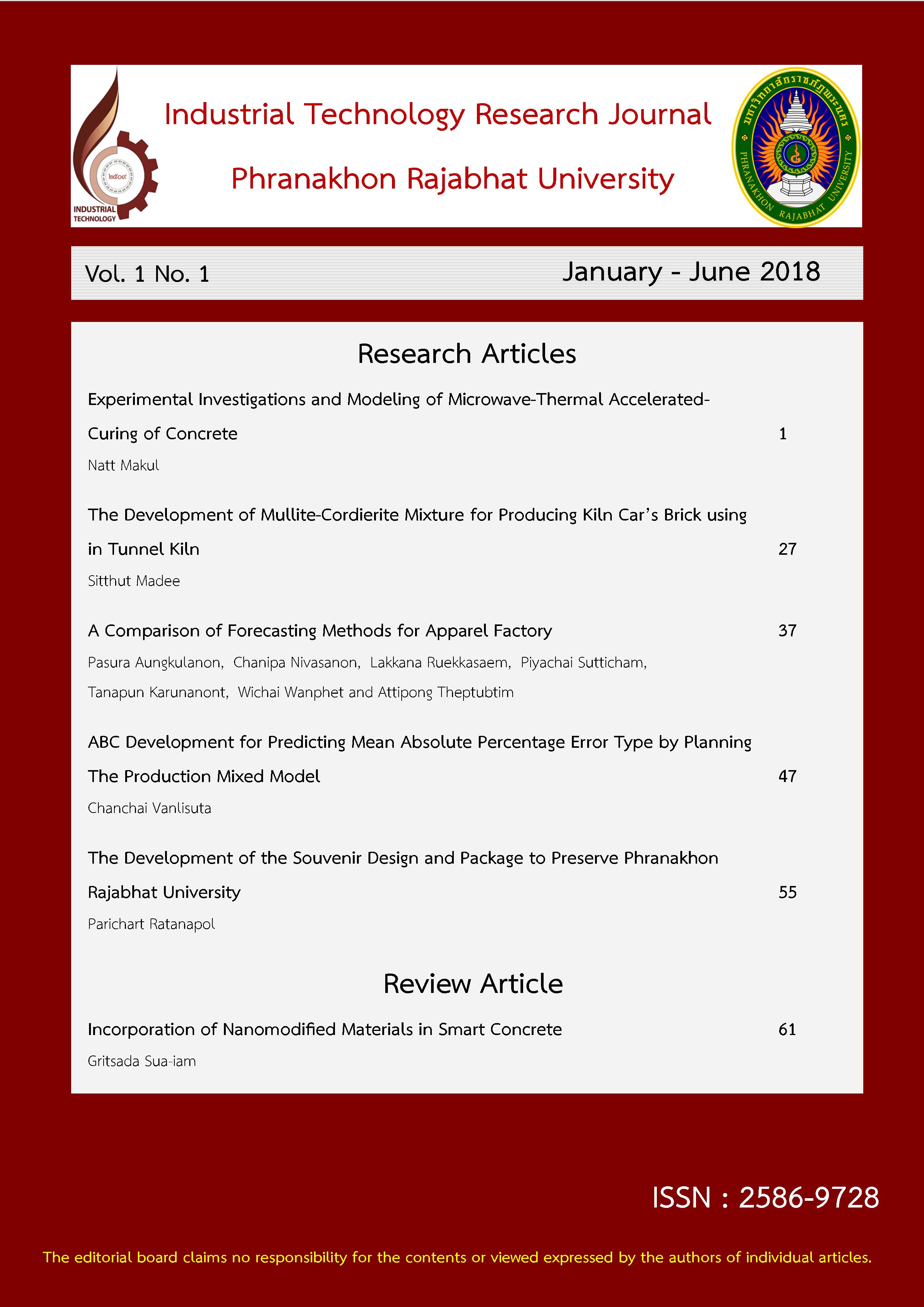Experimental Investigations and Modeling of Microwave-Thermal Accelerated-Curing of Concrete
Abstract
The use of microwave energy to acceleratingly cure concretes was presented. First, we measured the dielectric permittivity of concrete during a 24-hour first-hydration period at a operating frequency of 2.45 GHz. Second, we investigated, experimentally and theoretically, the characteristics of concrete as subjected to microwave energy with a multi-mode system, with specific attention to temperature rise, compressive strength, and the use of the maturity function. The results show that dielectric permittivity is relatively high and remains constant during the dormant period. After this period, the hydration reaction resumes and dielectric permittivity decreases rapidly. With the use of microwave heating, early-age strength increases during the first 14 days; however, during the next 14 days, early-age strength decreases slightly, until it reaches its lowest at the 28-day mark. The temperature rise as actually recorded at the center of the specimen during microwave heating in our experiment consistently agreed with figures calculated by a mathematical model.
References
2. Peyre, F., et al., 1997, “Influence of the Dielectric Property on Microwave Oven Heating Patterns: Application to Food Materials,” Journal of Micro-wave Power and Electromagnetic Energy, Vol. 32, Issue 1: pp. 3–15.
3. Beall, F.C., 2007, “Industrial Applications and Opportunities for Nondestructive Evaluation of Structural Wood Members,” Maderas: Cienciay Tecnologia, Vol. 9, Issue 2: pp. 127–134.
4. Chen, H., 2008, “Simulation Model for Moving Food Packages in Microwave Heating Processes using Conformal FDTD Method”, Journal of Food Engineering, Vol. 88, Issue 3: pp. 294–305.
5. Orsat, V., 2007, “Microwave-assisted Drying of Biomaterials,” Food and Bioproducts Processing, Vol. 85, Issue 3C: pp. 255–263.
6. Sgriccia, N., Hawley, M.C., 1991, “Thermal, Morphological, and Electrical Characterization of Microwave Processed Natural Fiber Composites,” Composites Science and Technology, Vol. 67, Issue 9: pp. 1986-1991.
7. Li, W., Ebadian, M.A., White, T.L., Grubb, R.G, and Foster, D., 1995, “Heat Transfer within a Concrete Slab with a Finite Microwave Heating Source,” International Journal of Heat and Mass Transfer, Vol. 38, No. 5: pp. 887–897.
8. Lagos, L.E., et al., 1995, “Heat Transfer within a Concrete Slab with a Finite Microwave Heating Source,” International Journal of Heat and Mass Transfer, Vol. 38: pp. 880–897.
9. Bažant Z.P., and Zi G., 2003, “Decontamination of Radionuclides from Concrete by Microwave Heating. I: Theory,” Journal of Engineering Mechanics, Vol. 129: pp. 777–784.
10. Arunachalam, K., 2008, “Characterization of a Digital Microwave Radiometry System for Noninvasive Thermometry using a Temperature–controlled Homogeneous Test Load,”, Physics in Medicine and Biology, Vol. 53: pp. 3883–3901.
11. Leung, K.Y.C., and Pheeraphan, T., 1995, “Microwave Curing of Portland Cement Concrete: Experimental Results and Feasibility for Practical Applications,” Construction and Building Materials, Vol. 9, No. 2, pp. 67–73.
12. Hutchinson, R.G., et al., 1991, “Thermal Acceleration of Portland Cement Mortars with Microwave Energy,” Cement and Concrete Research, Vol. 21: pp. 795–799.
13. Ratanadecho, P., 2002, “Microwave Heating Using a Rectangular Wave Guide,” Doctoral Dissertation, Nakaoka University of Technology.
14. Rhim, H. C., and Buyukozturk, O., 1995, “Electromagnetic Properties of Concrete at Microwave Frequency Range,” ACI Materials Journal, Vol. 95–M25: pp. 262–271.
15. Moukwa, M., et al., 1991, “The Influence of the Hydration Process upon Microwave Properties of Cements,” Cement and Concrete Research, Vol. 21: pp. 863–872.
16. Hutchinson, R.G., et al., 1991, “Thermal Acceleration of Portland Cement Mortars with Microwave Energy,” Cement and Concrete Research, Vol. 21: pp. 795–799.
17. Pheeraphan, T., 1997, “Accelerated Curing of Concrete with Microwave Energy,” Doctor of Philosophy Dissertation, MIT.
18. Dongxu, L., and Xuequan, W., 1994, “A Study on the Application of Vacuum Microwave Composite Dewatering Technique in Concrete Engineering,” Cement and Concrete Research, Vol. 24: pp. 159–164.
19. American Society for Testing and Materials, 2008. “Annual Book of ASTM Standard Vol. 4.02,” Philadelphia, PA, USA.
20. American Society for Testing and Materials, 2008, “Annual Book of ASTM Standard Vol. 4.01,” Philadelphia, PA, USA.
21. HP, Dielectric Probe Kit 85070A. Palo Alto, 1992, CA: Research and Development Unit, Test and Measurements Laboratories, Hewlett Packard Corporation.
22. Venkatesh, M.S., Raghevan, G.S.V., 2005, “An Overview of Dielectric Properties Measuring Techniques.” Canadian Biosystems Engineering, Vol. 47: pp 15–29.
23. Udaya, B.H., Sotoodehnia, A., Maser, K.R., and Kausel, E.A., 1993, “Modeling the Electro-magnetic Properties of Concrete,” ACI Materials Journal.
24. Rattanadecho, P., Suwannapum, N., Chatveera, B., Atong, D., and Makul, N., 2008, “Development of Compressive Strength of Cement Paste under Accelerated Curing by Using a Continuous Microwave Thermal Processor,” Material Science and Engineering A, 472, No. 2: pp. 299–307.
25. Hewlett, P.C., 1998, Lea’s Chemistry of Cement and Cementitious Material, 4th Edition, New York: John Wiley & Sons Inc.
26. Taylor, H.F.W., 1997, Cement Chemistry, 2nd Edition, Great Britain: Thomas Telford Publishing.
27. Cario, N., 1993, “The Maturity Method: Theory and Application,” Cement, Concrete & Aggregates, Vol. 6, No. 2: pp. 61–73.
28. Benameur, H.K., Wirquin, E., and Duthoit, B., 2000, “Determination of Apparent Activation Energy of Concrete by Isothermal Calorimetry,” Cement and Concrete Research, Vol. 30: pp. 301–305.
29. Aloia, L.D., and Chanvillard, G., 2002, “Determining the ‘Apparent’ Activation Energy of Concrete Ea—Numerical Simulations of the Heat of Hydration of Cement,” Cement and Concrete Research, Vol. 32: pp. 1277–1289.



